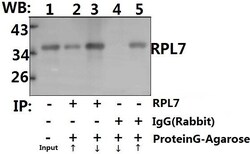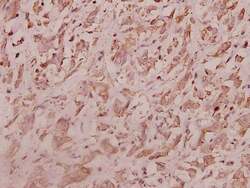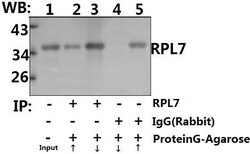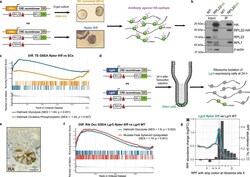Antibody data
- Antibody Data
- Antigen structure
- References [1]
- Comments [0]
- Validations
- Immunoprecipitation [1]
- Immunohistochemistry [2]
- Other assay [2]
Submit
Validation data
Reference
Comment
Report error
- Product number
- PA5-36571 - Provider product page

- Provider
- Invitrogen Antibodies
- Product name
- RPL7 Polyclonal Antibody
- Antibody type
- Polyclonal
- Antigen
- Synthetic peptide
- Description
- This antibody detects endogenous protein at a molecular weight of 29 kDa. Purity is >95% by SDS-PAGE.
- Reactivity
- Human, Mouse, Rat
- Host
- Rabbit
- Isotype
- IgG
- Vial size
- 100 µL
- Concentration
- 1 mg/mL
- Storage
- Store at 4°C short term. For long term storage, store at -20°C, avoiding freeze/thaw cycles.
Submitted references Ribosome impairment regulates intestinal stem cell identity via ZAKɑ activation.
Silva J, Alkan F, Ramalho S, Snieckute G, Prekovic S, Garcia AK, Hernández-Pérez S, van der Kammen R, Barnum D, Hoekman L, Altelaar M, Zwart W, Suijkerbuijk SJE, Bekker-Jensen S, Faller WJ
Nature communications 2022 Aug 2;13(1):4492
Nature communications 2022 Aug 2;13(1):4492
No comments: Submit comment
Supportive validation
- Submitted by
- Invitrogen Antibodies (provider)
- Main image

- Experimental details
- Immunoprecipitation of RPL7 in HEK293T cell lysate (sepharose bead conjugate), (lane 2 and lane 3) and Nonspecific IgG Control (sepharose bead conjugate, lane 4 and lane 5). Lane 1 is 30% input. Samples were incubated with RPL7 polyclonal antibody (Product # PA5-36571) Results legends show supernatant (upward arrow) and deposition (downward arrow).
Supportive validation
- Submitted by
- Invitrogen Antibodies (provider)
- Main image

- Experimental details
- Immunohistochemistry analysis of RPL7 in paraffin-embedded human breast carcinoma tissue. Samples were incubated with RPL7 polyclonal antibody (Product # PA5-36571) at a dilution of 1:100.
- Submitted by
- Invitrogen Antibodies (provider)
- Main image

- Experimental details
- Immunohistochemical analysis of RPL7 in paraffin-embedded human breast carcinoma using RPL7 polyclonal antibody (Product # PA5-36571) at a dilution of 1:100.
Supportive validation
- Submitted by
- Invitrogen Antibodies (provider)
- Main image

- Experimental details
- Immunoprecipitation of RPL7 in HEK293T cell lysate (sepharose bead conjugate), (lane 2 and lane 3) and Nonspecific IgG Control (sepharose bead conjugate, lane 4 and lane 5). Lane 1 is 30% input. Samples were incubated with RPL7 polyclonal antibody (Product # PA5-36571) Results legends show supernatant (upward arrow) and deposition (downward arrow).
- Submitted by
- Invitrogen Antibodies (provider)
- Main image

- Experimental details
- Metabolism is translationally regulated in fetal-like ISCs. a Experimental workflow of the RiboSeq experiment comparing the translatome of Rptor fl/fl organoids to WT. Crypt cultures were generated from VillinCre ERT2 RPL22.HA mice both in the presence and absence of Raptor. Tagged ribosomes were pulldown using an HA antibody and ribosome protected fragments were sequenced and mapped to the genome. b Western blot analysis confirming efficient pulldown of HA-tagged RPL22 ribosomes. RPL7 co-immunoprecipitation is used as an indicator of intact ribosomes. beta-actin serves as a loading control. Experiments were done in one biological replicate. c Gene Set Enrichment Analysis based on differential translation efficiency data comparing Rptor fl/fl organoids to stem cell enriched cultures ( n = 3). Enrichment is shown for transcriptional signatures related to oxidative phosphorylation and glycolysis. p values were determined using the clusterProfiler package. d Experimental workflow of the RiboSeq experiment comparing the translatome of intestinal stem cells from Rptor fl/fl to WT mice. Ribosomes were tagged specifically in the instestinal stem cells of mice using an Lgr5Cre ERT2 promoter, both in the presence and absence of Raptor. 24 h after tamoxifen induction, the ribosomes are recombined with the HA tag exclusively in the intestinal stem cells, allowing the capture and further study of their translatome by RiboSeq. e Imunohistochemistry staining of Lgr5Cre ERT2 RPL22.HA intest
 Explore
Explore Validate
Validate Learn
Learn Western blot
Western blot Immunoprecipitation
Immunoprecipitation